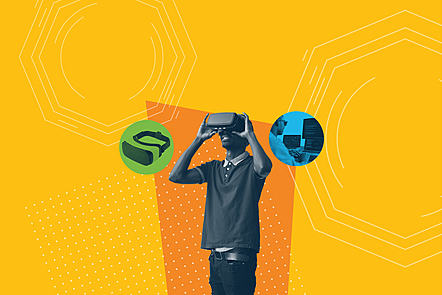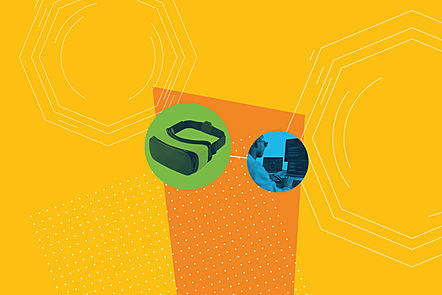What is the metaverse?
Wondering what the metaverse is and how it'll work? We discuss everything you need to know about this futuristic technology.

In October 2021, Facebook made a surprising announcement. The parent company, Facebook Inc., would be changing its name to Meta Platforms. This rebranding is part of the company’s shift to a new way of doing things on the internet. While Meta Platforms is ahead of the game in terms of names, the metaverse isn’t the property of any one company.
The idea of a metaverse isn’t a new one. Neal Stephenson coined the term in his influential cyberpunk novel, Snow Crash, all the way back in 1992. The concept has become a staple of science fiction, and a feature of everything from films such as The Matrix to Ready Player One.
The company formerly known as Facebook has been laying the groundwork for this move for quite some time. Nearly a decade ago, it acquired virtual-reality-headset manufacturer Oculus VR — the technology acquired in the process is likely to be foundational to the metaverse. The company has quietly poured around $10 billion into metaverse-related technologies over the last year.
And it’s not just one company that’s bought into the idea. In January 2022, Microsoft announced that it would buy video-game juggernaut Activision Blizzard for a record-breaking $70 billion, in order to provide ‘the building blocks for the metaverse’. To put this into perspective, that’s around ten times the price laid out for Zenimax Media (whose subsidiaries have produced The Elder Scrolls, Doom and Fallout, among others) in 2021.
For some, this is a sign that we’re on the cusp of the biggest tech revolution since the introduction of the internet. And, like the internet, it’ll be transformative and completely unanticipated by everyone outside a tiny Silicon Valley cabal.
Like it or not, the metaverse is coming. As with AI, CRISPR, the Internet of Things, and other transformative future technologies, it’s going to bring benefits and risks. Considering those risks ahead of time is essential.
Defining the Metaverse
You can think of the metaverse as a series of interconnected virtual worlds. Items that exist in one space can be transferred to another. This contrasts with the current state of affairs, where assets are locked to a given platform. For example, if you download Zlatan Ibrahimovic in the latest FIFA game, then you can’t import him into Call of Duty (or into a Zoom call or PowerPoint presentation).
It’s this interoperability that defines the metaverse. While we might be able to buy items in some games, and attend online events in another, these are all separate experiences. By connecting everything together, we get something that’s different from the internet as we know it now.
Eric Ravenscroft over at Wired draws a comparison with the term ‘Cyberspace’. The two terms are interchangeable most of the time because neither refers to any specific technology, but more to a change in the way we use technology.
How might the metaverse work?
Speculating about how this might all work in practice is difficult. Even Meta Inc has had to resort to some fairly imaginative CGI work to paint a picture. A promotional video features a man sitting down at a desk, donning a pair of glasses and being suddenly surrounded by his virtual workmates.
But in principle, the idea is that the metaverse could overlay the real world, and perhaps become indistinguishable from it. You might put on a 3D headset and dive into a meeting where you and your workmates are represented by virtual avatars. You might then go for a social event, such as a concert, using the very same set of technologies.
You could even attend classes using virtual reality — which would mean access to education on a scale that would be impossible using traditional means. For example, you could go instantly from a virtual classroom environment to a virtual tour of a historic setting.
It’s clear that this transition is going to be hugely consequential for the workforce. It will create new kinds of work, and render others obsolete. If you’ve been considering a new digital career, then this might just be the kickstart that’s required.


Metaverse gaming
Just about every discussion of the metaverse — and the technologies associated with it — focuses heavily on gaming. Video games, after all, take place in virtual worlds — and thus it’s no surprise that they’re at the sharp end of metaverse-related innovation.
Announcing Microsoft’s acquisition of Activision Blizzard, the chief executive Satya Nadella made the case crystal clear: “Gaming is the most dynamic and exciting category in entertainment across all platforms today and will play a key role in the development of metaverse platforms.”
Getting started with VR, AR and MR
The metaverse will rely on building a simulated environment. This means making use of virtual reality of some kind. Let’s dwell on some of the terminology being used.
Virtual Reality is where digitally rendered environments take the place of real ones. Generally speaking, the term is most often used to describe an environment that supplants your sense of self, such that you forget about the real world. This is achieved through stereoscopic visuals, sound and motion sensors — allowing you to turn your head and look around.
Advances in rendering, combined with modern VR headsets, are likely to provide a fairly convincing imitation of reality. If you don’t yet appreciate how close this is to actually happening, you might take a look at the latest Unreal 5 demonstration, which brings together a whole range of rendering techniques to create something truly unprecedented for real-time rendering. It seems entirely possible that in a decade, some games will be impossible to distinguish from the real world.
Augmented reality is where virtual items are overlaid onto the real world. On sci-fi shows like Black Mirror, this could mean getting a heart-rate monitor digitally projected onto the inside of your retina. In the real world, Pokémon Go is a good example of AR. The stage in between these two concepts might involve wearing special glasses — but persuading people that this is worth doing may require a bit of a cultural shift.
Mixed reality is a term that heavily overlaps augmented reality. It provides a mixture of the real and virtual worlds, and allows you to interact with both seamlessly without removing your headset.
The metaverse, cryptocurrencies and NFTs
Metaverse cryptocurrencies
Investors have begun to flock to a handful of cryptocurrencies that promise to take advantage of the metaverse-enabled future. If you don’t know, a cryptocurrency is a type of virtual payment that can be used without the need for a bank or government monetary authority.
These innovations tend to have a more decentralised approach, which doesn’t rely on massive corporate structures. Perhaps in time these will collapse into a single metaverse coin — but for the moment they’re disparate inventions.
The Sandbox presents a plausible candidate for a metaverse currency. It’s a decentralised gaming platform that’s based around the Ethereum blockchain. SAND — the currency of the game — can be used to buy digital assets, whose ownership can be locked in cryptographically. So, you might buy a digital cow using SAND, and the Sandbox blockchain could be used to prove that you, and no-one else, were the owner of that cow.
NFTs in the Metaverse
Non-Fungible Tokens (or NFTs) are another form of cryptographic asset. Unlike cryptocurrencies, they can’t be divided or exchanged for identical tokens — each token is unique. So, the digital cow we just mentioned might fall into that category (provided that there aren’t other cows just like it).
Decentraland, another Ethereum-based virtual platform, uses a system of digital real estate called LAND, which works alongside its native cryptocurrency, MANA. Since the two can be exchanged, inhabitants of the platform can monetise their online creations. Axie Infinity does much the same thing, except instead of selling land you’re selling unique monsters called Axies.
Metaverse marketing
If so many billions of people are going to be inhabiting this virtual environment shortly, then there will be plenty of human attention to be bought and sold. VR provides an excellent opportunity for brands to tell their stories. Entirely new methods will need to be developed if we are to get the most out of these platforms.
Product placement is an established practice in virtual environments, with gaming making fertile ground for advertisers. Racing games feature real-life cars, and sports games feature real-life advertising hoardings. Deliveroo managed to do this unobtrusively by getting virtual riders to deliver food in Animal Crossing. Louis Vuitton launched an entire game with a view to promoting its brand.






Problems with the metaverse
You might have noticed something about all the fictional metaverses we listed at the start. In them, the virtual world is almost always dystopian. In the Matrix, Neo starts (spoiler alert) by escaping the titular nightmare into the real world, and freeing everyone else, too. You’ll find echoes of this arc throughout the genre. Even in the apparently optimistic future of Star Trek, Reginald Barclay becomes addicted to the holodeck.
So, is the real Metaverse likely to be a bad thing? What drawbacks might we anticipate?
Bad behaviour in the metaverse
As anyone with any sort of presence on social media will tell you, people behave very differently on the internet than they do in real life. They’re rude, to the point of abusiveness. Troll subculture, which involves deliberately tormenting people on the internet, has provided entirely novel and innovative forms of nastiness.
The internet as it currently stands is often described as a ‘Wild West’, with bad actors running rampant and everyone else being marginalised. There’s little in the way of personal accountability — for individuals or tech giants. While the technology has undoubtedly done a lot of good, it has also helped to radicalise, repress, divide and misinform.
The emergence of a metaverse may well amplify these negative consequences because it’s an order of magnitude more immersive than the traditional internet. If a Twitter pile-on can feel horrible, imagine how much worse it would be if all of the people yelling at you were realistically rendered.
Privacy
Facebook already requires that users submit their real name, address and phone number. They recently attracted criticism when WhatsApp changed its terms of privacy in a way that could conceivably have seen data harvested and sent to the parent company. Though Meta itself contests this, WhatsApp has been fined £190m by the data protection authorities in Ireland, in the second-largest ever GDPR penalty.
The issue is likely to be made thornier by the introduction of the metaverse, especially if our digital identities are contingent on our handing over our personal information to huge tech companies and their sponsors.
Addiction
If the virtual world is really that compelling then, almost inevitably, it will become addictive. This is a problem that isn’t unique to the metaverse: for decades, game designers have known which levers to pull in order to get us compulsively clicking.
Diablo made a feature of random loot back in the mid-90s — kill a monster and there’s a very small chance you’ll get a unique piece of loot. Since then, the art of the loot-box has been refined to the point where millions of players think nothing of exchanging real-world cash for a chance at virtual goods.
Of course, these game designers are exploiting psychological vulnerabilities that have been known about for much longer by the gambling industry. Slot-machines hold gamblers rapt for days on end; mice can be persuaded to press a lever compulsively when the rewards for doing so are randomised.
The metaverse could conceivably amplify this sort of compulsive behaviour by making the reward that much more consequential and visceral. If Diablo can make us jump up and down with excitement over a crudely rendered weapon tumbling out of a demon, then it’s easy to see how players might be conditioned to come back more and more often to the virtual world, and ultimately prefer it to the real one.
To counter all of this, people might be required to limit their exposure, take pre-emptive interest in their own digital wellness, and occasionally treat themselves to a digital detox.
Do we actually need the metaverse?
The simple answer to this question is no. We don’t need the metaverse. But the same might be said of the internet, computers, the car, the wheel, and just about every other type of technology.
In the case of the metaverse, it’s difficult to quantify the productive advantages. There are simply too many variables. We can describe the output of an internal combustion engine in terms of its ‘horsepower’. It’s more difficult to do the same thing with this new set of technologies.
The internet, as well as accelerating previous trends (like rapid proliferation of newspapers, and the exchange of ideas via text), has also given rise to entirely new ways of doing things. If you were to explain the influence of Twitter on Westminster political reporting to a person living in the year 2000, you might be treated as though you were faintly eccentric.
You’d have to explain what Twitter is and the effects of this kind of service on the human brain, and on human society. Before this kind of technology arrived, these effects were mostly unknowable — we simply hadn’t done the experiment to discover what might happen. The same is almost certainly true of the metaverse.
Final thoughts
While Meta’s marketing department might paint a rosy picture of a life in the virtual world, complete with holographic teleconferencing and simulated office life, the technology that would underlie such a future hasn’t been built yet.
The modern internet evolved in a direction that only a prescient minority actually anticipated. There’s every reason to suppose that the metaverse’s future trajectory will be similarly difficult to predict.







